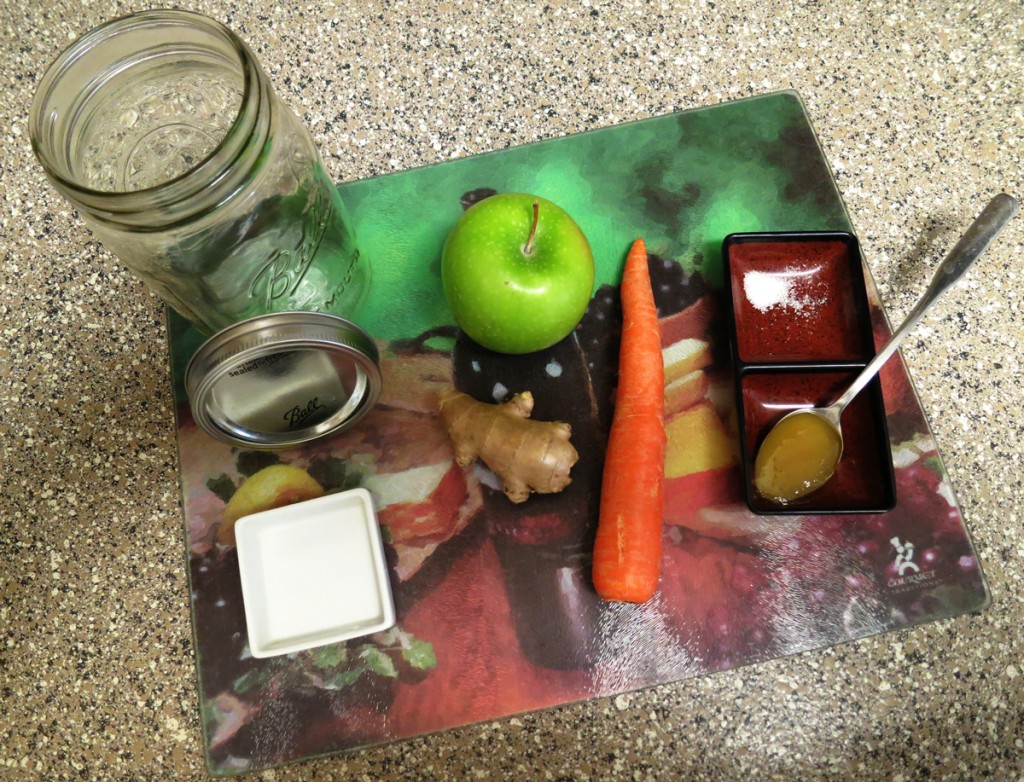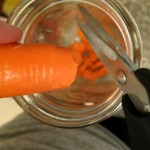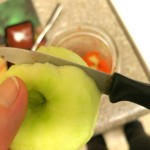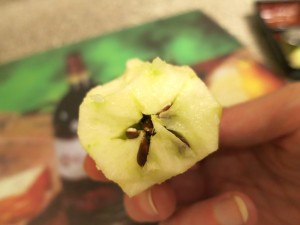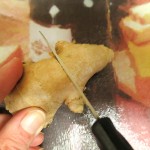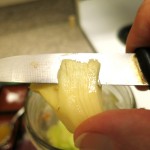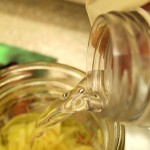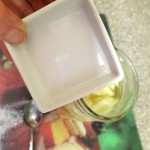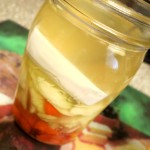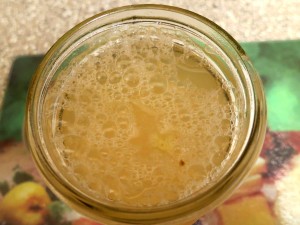Tag : health
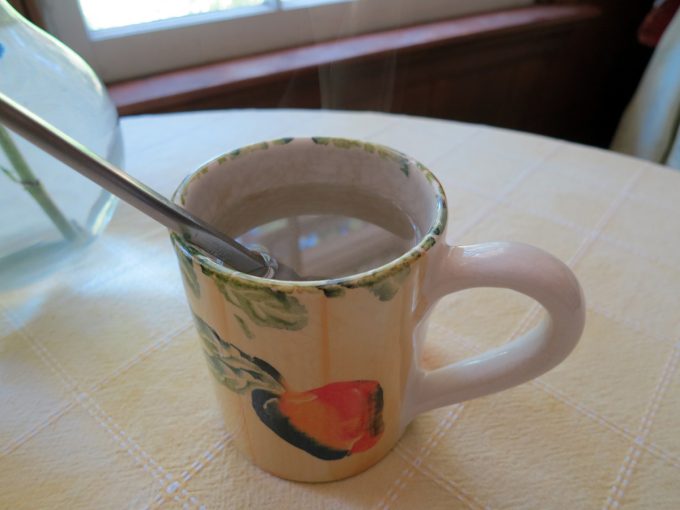
This ginger tea recipe is as simple as a crystal-clear blue sky…just two ingredients. As always, organic is preferable.
You’ll need these two items:
- 1 – 2 Dashes Ginger Powder
- 1 Small Spoon Stevia Powder
…and you’ll also want to have on hand some hot water and a tea mug 🙂
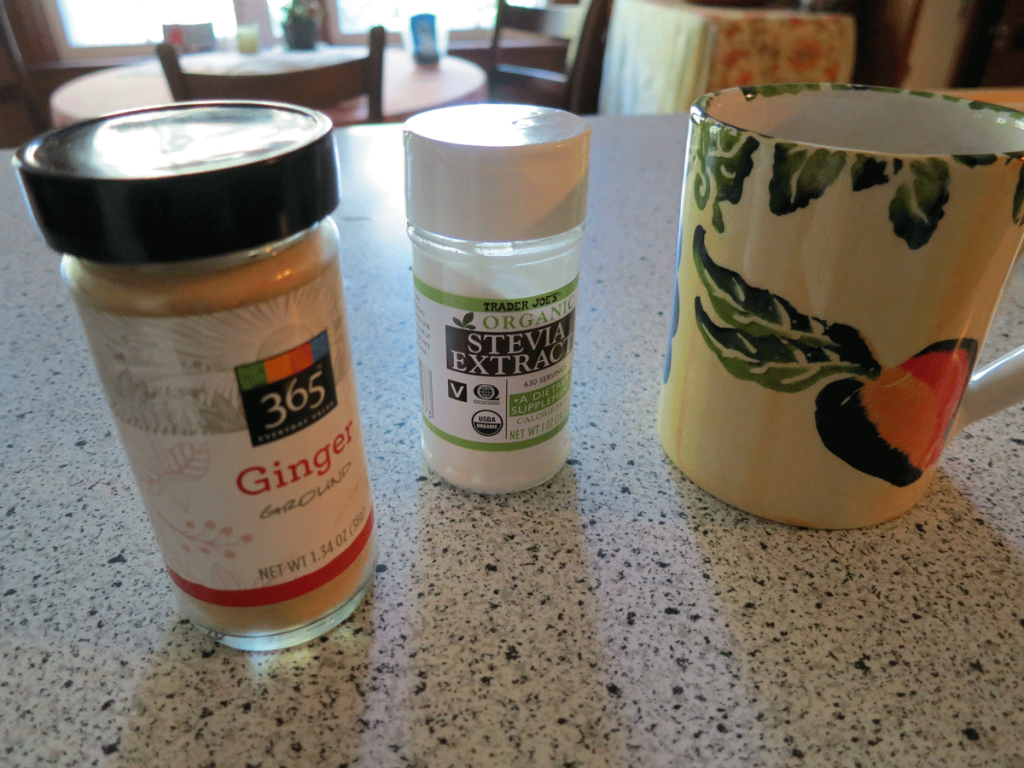
Add 1 – 2 dashes ginger powder to your tea mug:
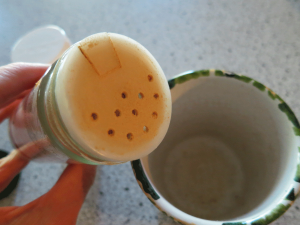
Next, add in the stevia…
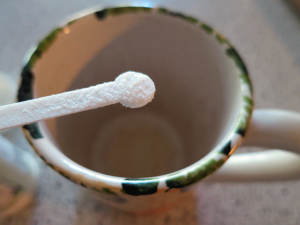
…and note how I’m using the little white spoon that usually comes with a container of stevia. Also note that I let the stevia heap and crawl up the handle, because my sweet tooth will have me asking for sweet things long after I’ve left this mortal coil.
Lastly, pour in some hot water, stir and you’re good to go! Very helpful to sip this with a meal…ginger is a well-known digestive, and is among my favorites aside from chewing fennel seeds or having a glass of red wine.
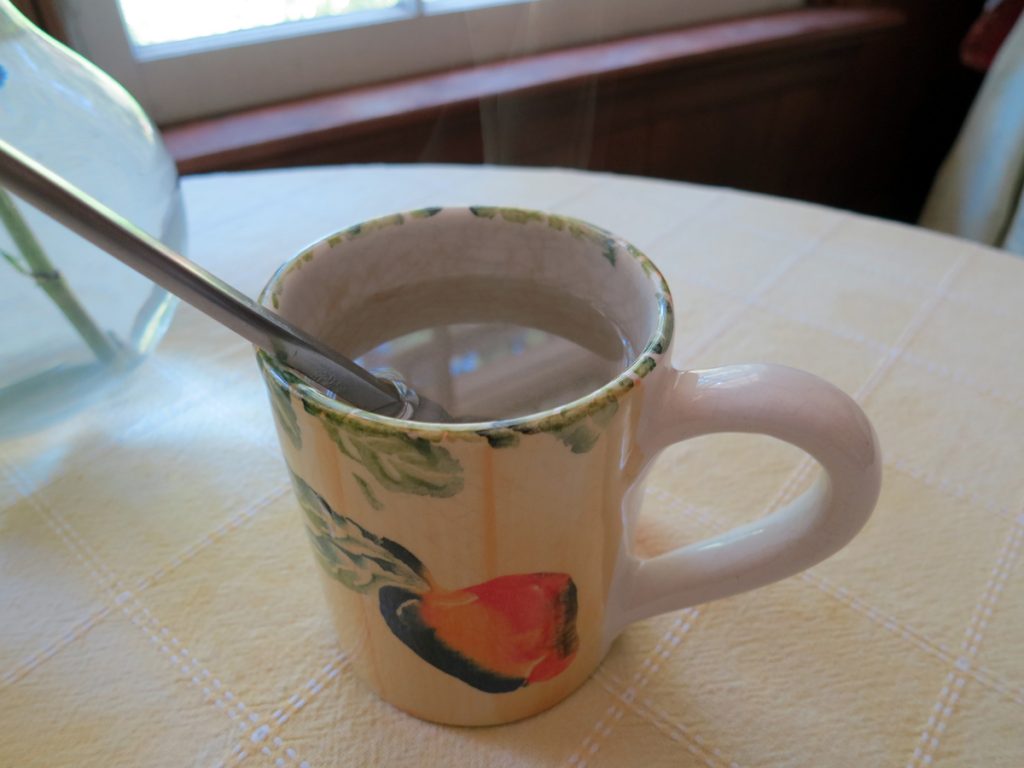
Drink up and enjoy!
Yours in Great Health,
Alison
Okay…so I admit it. Brushing one’s teeth with candy does sound a little off. But when you qualify the candy by what’s in it, it is not too big of a flying leap.
Case in point, xylitol candy, which is now up front and center in just about every grocery store I venture into. Xylitol is very well known to have beneficial effects on teeth, and after my Mexican dental clinic in Tijuana prescribed me a mouthwash with xylitol as its main ingredient, I decided to try brushing with a few candies I liked that had it, too.
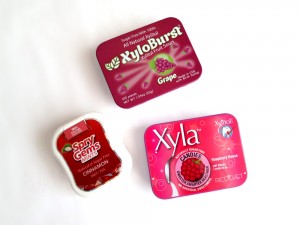 Enter Xyla, XyloBurst and Spry Gems, all of which feature xylitol as the main sweetener, and it’s a sweetener with many benefits. Lots of cancer survivors I’ve talked to use it as one of their mainstays in addition to stevia. So why not use it for scrubbing the pearly-whites?
Enter Xyla, XyloBurst and Spry Gems, all of which feature xylitol as the main sweetener, and it’s a sweetener with many benefits. Lots of cancer survivors I’ve talked to use it as one of their mainstays in addition to stevia. So why not use it for scrubbing the pearly-whites?
Considering some of the ingredients I’ve seen in “conventional” toothpastes (as well as those considered “natural” or “healthy”) – and given my knack for quick demineralization and the resulting teeth issues – I decided to give it a go. And now, four months later, I can honestly say my teeth don’t hurt as much as they used to, they are clean, not too much in the way of that scummy buildup on the surface and I don’t miss toothpaste too much at all.
My favorite candy to brush with (and this does involve chewing the candy a bit and letting it mix with saliva, then brushing) turns out to be Spry Gems, which have the added ingredient of calcium glycerophosphate, which has been studied for its anti-cavity effects.
Research on calcium glycerophosphate suggests a strong benefit in its ability to inhibit plaque formation and tooth decay (“caries”) in the mouth. An article entitled Calcium Glycerophosphate and Caries: A Review of the Literature, states:
“There is credible evidence that calcium glycerophosphate has the potential to reduce the progression of caries via all of these mechanisms if it is applied frequently and at a sufficiently high concentration.”
There is one caveat I will mention – calcium glycerophosphate, when ingested, can have the effect of lowering one’s stomach acid, and as one who has had serious problems due to low stomach acidity, I have to really watch this. Using the Gems as “mints” and ingesting them has proven not to be the best thing for me. This is why when I chew the Gems and brush with them, as with any regular toothpaste, I don’t swallow – I spit.
Still, the combination of the calcium glycerophosphate and xylitol is a good one, as long as I use it in a way that benefits me personally and not necessarily “as directed.” Even so, the Cinnamon flavored Spry Gems have become a favorite, and if I can’t find those, I sometimes make do with XyloBurst Grape or berry-flavored Xyla candies.
Variety is good, and if I find I want to skip the calcium glycerophosphate for a while, they are a fine substitute…and with these, I can swallow to my heart’s content…or not. If I’m feelin’ like I’m into that sorta thing.
The important thing is, my teeth love ’em all! And they are healthier these days than ever.
Enjoy,
Alison
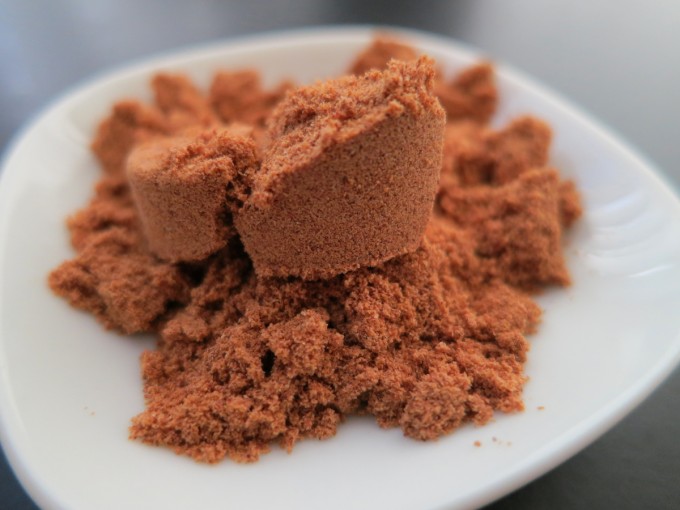
I first started eating fruit seeds some time ago after being told they contained beneficial and cancer-fighting substances like laetrile, which is found in apple and apricot seeds.
In 2012, while dealing with the nipple cancer lesion in my left breast, I came across a recommendation to use ellagic acid to help my body fight off tumors, my naturopathic MD in Los Angeles telling me that as long as I had enough antioxidants, I was protected.
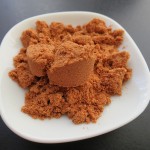 Ellagic acid is a naturally-occurring phenolic antioxidant contained in many fruits and vegetables, and had been recommended to me as being suitable for my needs. At first, I tried a supplement that combined ellagic acid with graviola, which had long been my standby for helping fight cancers.
Ellagic acid is a naturally-occurring phenolic antioxidant contained in many fruits and vegetables, and had been recommended to me as being suitable for my needs. At first, I tried a supplement that combined ellagic acid with graviola, which had long been my standby for helping fight cancers.
To my disappointment, the supplement didn’t agree with me – it was too concentrated for me at a time when I was also doing a very intense, year-long heavy metals detox on a three-days-on/four-days-off schedule using zeolite, cilantro and blue-green algae, including spirulina and chlorella.
The positive changes taking place in my body during this detox were nothing short of spectacular, and as bodies so often do, mine was changing. For the better. For me, it meant I had less and less use for supplements in general, including ellagic acid in concentrated supplement form.
In short: I needed to find something more food-like and body-compatible, rather than a refined and super-concentrated supplement.
I researched a little deeper and found that ellagic acid had precursors known as ellagitannins, that provide quite a bit more bioavailability in a much closer-to-nature form. That sounded good to me!
Enter Raspex Red Raspberry Seed Powder, made largely from a variety of the berry called Meeker Raspberries – those which contain the highest levels of ellagitannins that break down into beneficial ellagic acid in the body.
This is a powder made of finely-ground Meeker raspberry seeds, and is a beautiful berry color. Mixed with an avocado smoothie, it’s fantastic. Stirred into plain organic yogurt with a little stevia produces an almost parfait-like dessert item. I keep a container of it handy at all times and keep it refrigerated as recommended. I can think of no better way to get tons of beneficial antioxidants into my system.
That said, the powder is a bit hard to swallow by itself or with plain water – it does have some grit to it and unless it’s mixed into something, it can be rather scratchy. But that is a small inconvenience for the amount of antioxidants this lovely powder delivers into your system.
It has become a part of a regimen that includes Chinese and Naturopathic medicine, diet, herbs, exercise – pretty much all the things you’ll read on the My Cancer Protocol page on this site, which I update periodically. As always, do your own research and find what works for you!
I buy mine online from either SMDI or Amazon. It retails for around US $39.95 (or therabouts) and comes in a one-pound tub that can be popped right into the fridge upon arrival.
Yours in Great Health,
Alison
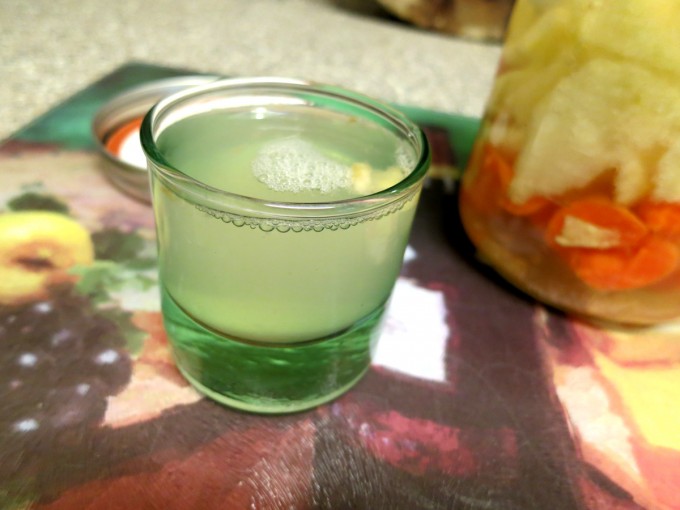
For years, I’d spent considerable money on probiotic supplements, some of them $50 a small bottle (or more). After that, I made water kefir using grains and a kit I’d bought on eBay, which was an interesting experiment in learning how to make yummy freeze-dried strawberry soda. Much cheaper, but it was altogether way too high in sugar.
Flash forward to two months ago when I got a hint from a friend in the know that I could just use some fruit, honey and sea salt to make a fine probiotic drink with a better carb profile…without babysitting any grains or the like. He used some apples, berries and a little bit of honey sans the sea salt for his version, which was where I started. Experimenting some more, I decided to use a time-tested formula that many cancer survivors (and thrivers) I know use for juicing: apples, carrots and ginger root. Except I would ferment them instead of juicing them.
I ended up with a great recipe containing live probiotics that is not only healthful and quite tasty, but produces zero waste in the bargain. Big on taste, zero waste.
Onward. Please gather the following items…and use organic where possible:
- Green Apple
- Mid-sized Carrot
- About 4 cm of Ginger Root (thick, thin, less or more to your taste)
- Heaping Teaspoon of Honey (I use a long teaspoon like the ones I use to stir my iced tea, not a measuring spoon – see pic above)
- 2 – 3 Hearty Pinches of Sea Salt
You will also want to have on hand:
- Small Ceramic (a small ceramic is good – I use a cheesecake ceramic dish borrowed from the Bellagio)
- Wide Mouth Quart or Liter-sized Mason Jar
- Water (Spring is best – enough to nearly fill the Mason Jar)
Rinse the apple and carrot with spring water, brushing lightly and briefly with a veggie brush or a clean scrubbie…don’t overdo it as you want to preserve the soil-based microorganisms that are so beneficial. Slice your carrot into thin slices with knife or kitchen shears into the Mason jar. Eat or compost the ends. Follow with slicing the apple, peel it if you wish and save the peel for either eating or composting…same with the core. The seeds are full of natural, cancer-fighting laetrile and should be eaten with the core while making this drink 🙂
Next, lightly peel and slice your ginger. As with the carrot and apple, the thinner you slice it means more surface area for the good critters to grow on. Follow by adding enough spring water to come up about an inch – 2.5 cm – below the jar’s top lid.
Now, add the honey and pinches of sea salt. Stir until all the honey is dissolved using the long teaspoon. This will take a few minutes, and will get all the ingredients mixing together nicely for the fermentation. The honey and salt may seem counter-intuitive, but these are essential for minimizing any bad critters that might try to grow into your mix.
You’ll notice the apples will float, so the next step is to place your ceramic carefully into the jar such that it keeps all the fruit and veggies down. Use the long teaspoon for this as well.
If the water level comes to about 1 – 1.5 cm – or about half an inch – below the jar’s top lid, you’re golden. Seal it up! If it’s not quite there, add a little water. If it’s too close to the lid, spoon off a couple spoonfuls into a shot glass and drink up.
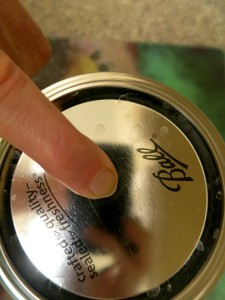 Let the mixture sit for 2-3 days before tasting. You should see small bubbles start to form, and when the lid cannot be pressed down, it is a good sign that you’ve got a good fermentation going. Letting the mixture ferment for 3 days is good before taking the first drinks, and I keep my shot glass nearby for the purpose. Smell the mix, if it smells warm and mildly sweet, you’re doing great. The Day 3 mix tastes mostly mellow and sweet, maybe a little tang, and just a little bite-y or fizzy. The longer you ferment, the more the sourness of the flavor grows…and I’ll point out here that it is good to smell the mix to make sure it hasn’t gone “off” – truth be told, I’ve never had a bad mix, but use common sense, pretty please.
Let the mixture sit for 2-3 days before tasting. You should see small bubbles start to form, and when the lid cannot be pressed down, it is a good sign that you’ve got a good fermentation going. Letting the mixture ferment for 3 days is good before taking the first drinks, and I keep my shot glass nearby for the purpose. Smell the mix, if it smells warm and mildly sweet, you’re doing great. The Day 3 mix tastes mostly mellow and sweet, maybe a little tang, and just a little bite-y or fizzy. The longer you ferment, the more the sourness of the flavor grows…and I’ll point out here that it is good to smell the mix to make sure it hasn’t gone “off” – truth be told, I’ve never had a bad mix, but use common sense, pretty please.
I find that Day 4 produces the flavor and the amount of fizz (quite a bit!) in the drink that I like most, so I take the most shots on this day…and yes, I’ve even had “die-off” or Herxheimers on occasion – this stuff does the job. After Day 4, I either let it sit out one more day and drink a more sour version, or I put in in the fridge on Day 4 to slow down the fermentation, though this reduces the fizz to almost nothing. I try and use up everything, liquid, solids and all, by Day 5. That seems to be the optimal time frame for taste, etc.
I often add a small amount of stevia to my shot glass with the probiotic drink – delicious! It tastes like a fizzy, slightly soured version of ginger ale, the stevia adding just the right amount of sweetness to make a sweet-tart and healthful drink.
As you drink and the liquid level lowers, the remaining apple-carrot-ginger solids and liquid can be refrigerated for a kvass-style probiotic digestive (click the “+” button at the top right of this page to see that image) that makes a great and very healthful side dish to any meal. Just a spoonful or two is wonderful, and soon you’ll have consumed all the liquid and the solids, meaning zero waste for this one.
Enjoy!
Yours in Great Health,
Alison
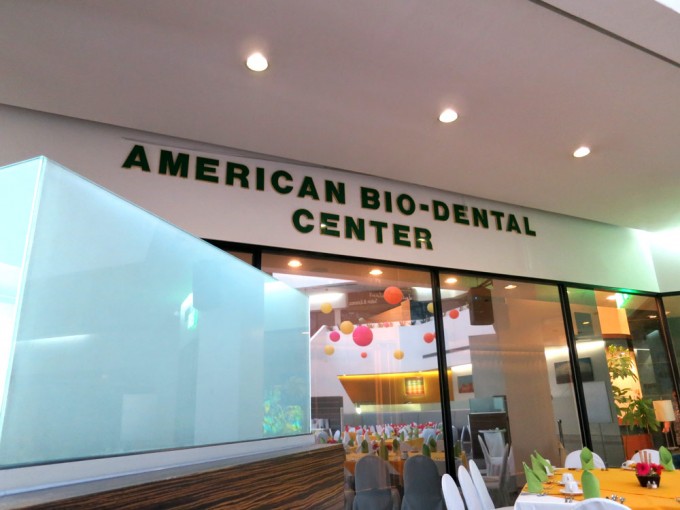
[This is a blog on my experiences travelling to and at American BioDental, a Mexican dental clinic specializing in holistic dentistry and alternative treatments for cancer, such as IV Vitamin C.]
While researching on treatment tactics for the breast lesion I was dealing with in 2012 and 2013, I found dental revision being recommended over and over as a foundation-level plank in the overall platform for beating cancer. Many self-directed cancer treatment sites even go so far as to say it may be enough in itself to clean up the dental environment to see big improvements, so my search was on!
Who knew this would be my view when I got there?
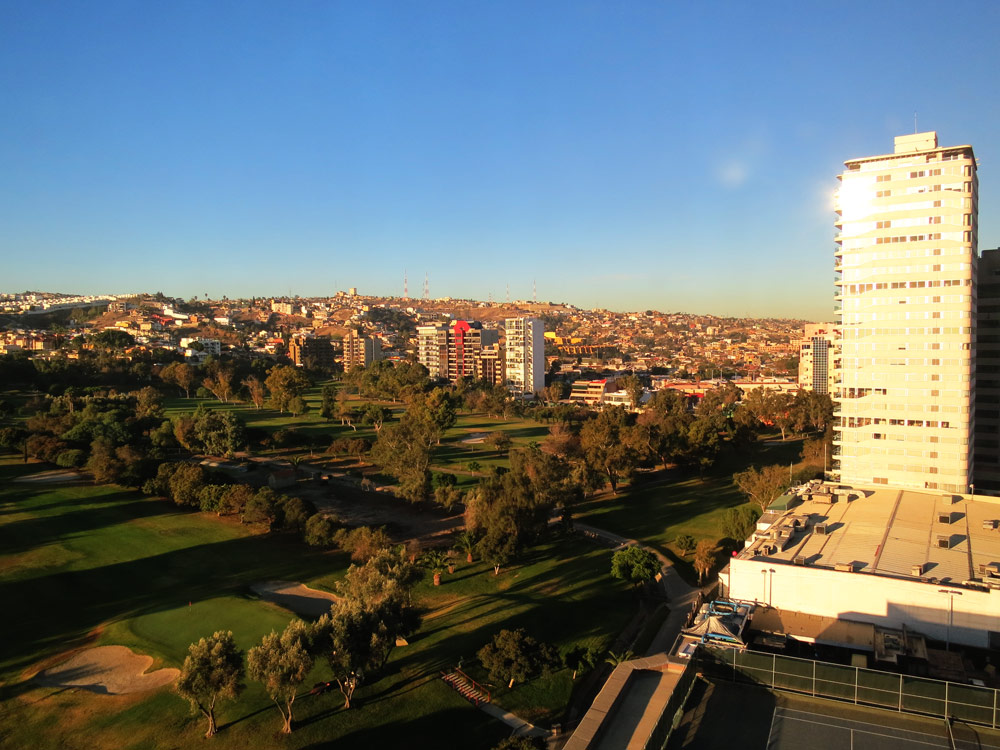
When looking around for a dentist to clean up the remaining mercury mess in my mouth, I sought four things:
- Simpatico. That whole feeling of likeability and ease of working together that is critical to any doctor-patient relationship, or should be. I’m not much of a yes-person and I sure don’t like being dictated to, then charged for it.
- Holistic. To a fault here, after years of having leaking mercury in my mouth, not by choice and which were never vetted as compatible with me…and, ummm, mercury isn’t compatible with…humankind.
- Qualitative. I wanted the best material my money could buy – and the least harmful, aka the most biocompatible. Anything being permanently placed in one’s mouth will certainly affect overall health. Profoundly.
- Affordable. I live in the US and own a body. Need I elaborate?
After much research and talking to various people, I chose American BioDental Clinic, located in Tijuana, Mexico. They hit favorable notes for all four of my requirements – whenever I called them, they happily explained everything and answered all my questions, including border-crossing options and then some. They specialize in holistic dentistry, including the removal of mercury, and I’d been in touch with several fellow survivors who’d gone there and reported success.
When I visited their website, I saw very reasonable pricing, and even more importantly, transparent and right out there for all to see. No having to call around and hear about payment plans that would have me in hock for years to come in the Great American Transfer of Wealth for what should be reasonably priced healthcare.
When I got to the Clinic, I saw that yes, their facilities were top-notch and yes, they used the best materials on the market for their patients – even encouraging them to get a biocompatibility test if they were dealing with cancer (my results).
After the initial intake and panoramic x-ray, I was told I had 23 teeth that needed work, including new fillings, replacement fillings, several inlays and a surgical mercury tattoo removal. Not being too much of a glutton for punishment, I arranged the work to be done in two parts – later that day, the right side of my mouth, top and bottom. Several weeks later, the left side. And then a third, very short visit for a quick follow-up on one problem tooth the dentists at the clinic saved with their excellent work, but told me to keep an eye on.
While under the drill, I also had Vitamin C IV drips – 50 grams each time – well-known to be extremely helpful for the immune system and a great treatment for cancer. Additionally, IV Vitamin C has the benefit of keeping re-exposure to heavy metals to a minimum while dental work is being done.
In my case, there were a lot of mercury tattoos left from half-assed amalgam removals not done safely or completely (but very expensively!) in the US back in 2008. After those, I’d thought – I’d hoped – that my problems were over. But they weren’t, as evidenced by ongoing cancerous lesions on my skin and left breast. Since there was still mercury residue in the form of grey-colored areas on my teeth and gums, along with loose fillings and cracks, the effects were still playing out in my system to my detriment.
Dental work and detoxes were in order, as soon as possible and within a reasonable budget, because it seems patients in the US are out of luck in getting mercury-related dental revisions paid for by the system that visited them upon us all. It would be akin to an admission that there was a problem, which I can only guess is a real no-no. It was only fitting that I took my business elsewhere.
So, on to the nitty gritty details about my trip(s) down under the USA’s southern border…
Crossing the Mexican border. I park and walk across, and for this, I take the 805 south to San Ysidro – the “LAST US EXIT” – the signs are very clear and say just that. At the end of the off-ramp, hang a right, go down the little hill, and what I usually do at the first intersection is make a right, then another quick right straight into a pay-as-you-go parking lot (cost, as of this writing: $7 per day). Park, and then you can either walk to the border crossing, or pay for one of the many rickshaws, etc., that come around looking to help out (plenty). I just walk it, it is not that far, and I don’t usually have more than a backpack.
Walking out of the parking lot toward the Mexican flag…which is right under the American flag in my pic…
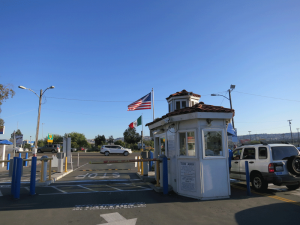

Once out of the lot, cross the street and hang a left to the intersection (pictured below), where you’ll cross the street using the crosswalk (shown below). After crossing, go straight…
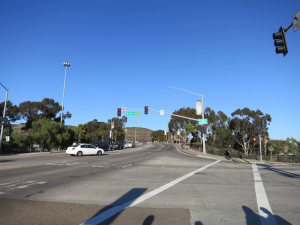
You’ll come to the pedestrian bridge that takes you back over the 805. You’ll see other people going where you want to go, so just follow them over the highway 🙂

You’ll come to a set of stairs, and at the bottom, go to the right and walk toward the train station area:

You’ll also see busses and lots of people, taxis and the like. The walkway to Mexico goes in between two buildings, then behind them and to the right. There’ll be plenty of others walking this route, and you’ll see this:
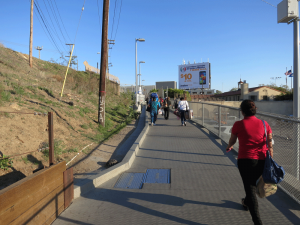
…and then you’ll see this…

…and you’ll realize that all the jokes are true: There really is a revolving door between Mexico and the US, lol! Two, in fact…
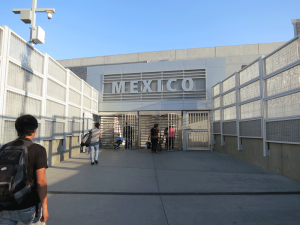
The revolving doors are the way to the “customs” area – and I put this in quotes, because it’s pretty basic – it is just a couple of revolving doors under the “MEXICO” sign (see the image above) that lead you into a small room where (sometimes) your bags are checked and (most of the time) you will see a member or two of the Mexican military standing guard as you exit.
After you exit customs, you’ll cross over the same highway in the other direction – and be warned, the path is just as circuitous as on the American side – to the taxi cab area. Per my previous advice, follow the crowd, they will lead you well. And note one of the first things you see on the Mexican side is a big pharmacy. Supply and demand. Go figure.
The taxi ride to the Grand Hotel Tijuana, where I usually stay when I have an appointment at American BioDental, is around $7 – 10, and takes around 10 minutes.
At the Grand Hotel Tijuana. This is a veeeerrrry niiiiiice hotel! You’ll pay the same for a shithole in LA, and with that, you’ll start to learn why over a million Americans call Mexico home, probably many of them “illegally.” The rooms are very nice and clean, have great bathrooms, and if you’re on one of the upper floors, you’ll have a fantastic view to boot. They have a very nutritious morning buffet, with complete proteins like eggs, chicken, beef, etc. You will not starve.

The water. Okay, had to get to this, and I’ll say this first: I drank the water freely on my first visit, and a few days later, had the most thorough and inexpensive full-body detox I’ve ever had. Otherwise known as Montezuma’s Revenge. Not very pleasant, but all-inclusive to a fault. The next few times I went, I was more careful, and I took a strong probiotic called Primal Defense with me. I think Saccharomyces Boullardi would also work well, just make sure to take enough of it. There is filtered water in the rooms, as pictured below:
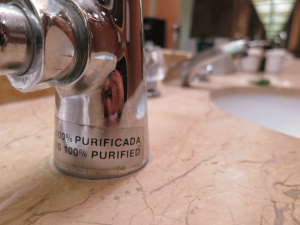
But…you know how it goes: Somehow, something always goes awry. The tea water isn’t quite boiled long enough to kill everything. Or, you brush your teeth and forget to use the filtered water. So I’m careful, and at restaurants, I usually order a mineral water called Ciel – it is canned and entirely (…uhhh, at least as far as canned drinks go) safe:
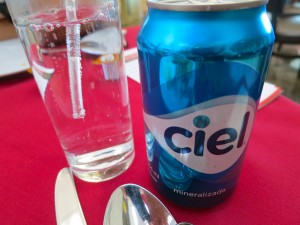
Going back to the US (do we have to?). One of the Alessandros, aka either American BioDental’s head doctor or his son, usually drives me and a few others back across the border. They usually leave once or twice per day, and this is VERY preferable to walking back across, as they have frequent crosser permits and it’s usually pretty painless. Take my word for it: Crossing into Mexico is a piece of cake. Crossing back into the US is an overblown exercise in paranoia. Go, and you’ll see for yourself.
Yours in Good Health,
Alison
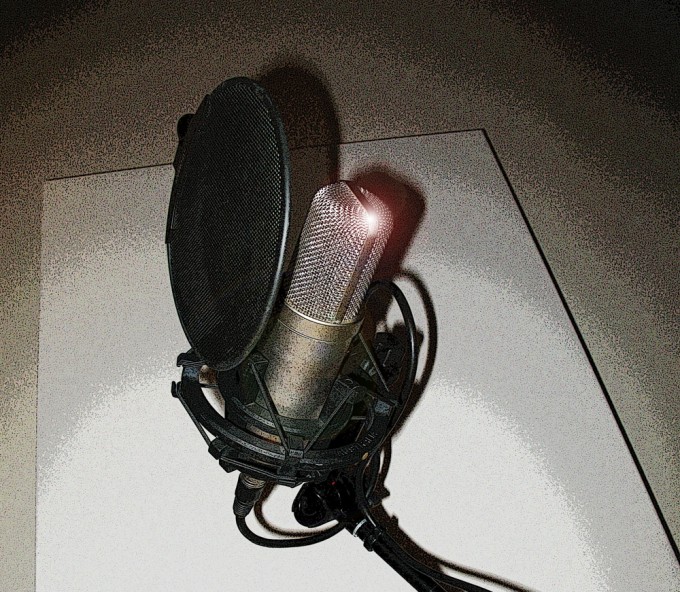
Yesterday, I attended a well-thought out, fact-and-numbers-based lecture given by Dr. Ken Osgood at the Unitarian Universalist Church in Las Vegas, the full title being the following:
The American Health System Dysfunctions – How We Got Here and What Needs To Be Done To Fix It
Speaking as someone with extensive experience with the US Healthcare system’s dysfunctions (and having to pay with no small amounts of money and time to resolve them), this was a presentation I could sink my teeth into where I learned quite a bit.
The lecture’s format traced the last 100 years of the American Healthcare System, how it came about and how it became the monster it is today. At the end, the presenter gave us all practical ways to effect changes in the system itself, starting from the patient’s perspective (i.e, the way it should be, but not the way it currently is). The message I got loud and clear: the system originated with us, and it has only grown out of control with our permission.
During the lecture, I learned that in America, we almost had a single-payer system. Nearly 100 years ago in 1920, a vote on a national healthcare system – akin to those in Europe and other nations – failed by a count of six votes.
If I could go back in time, no tellin’ what I’d do.
Flash forward to 1945 and a World War II-winning US, defined by a highly-skilled workforce that US industry could not afford to compensate accordingly and voila! We got socked with our employer-based healthcare system, with employer healthcare benefits coming in as an alternative to reasonable pay. Following that in 1965 came the introduction of the “third wheel” between patient and provider in the form of the fiscal intermediary concept. At the time, this included Medicare and Medicaid and has grown to include insurance companies, lawyers, courts, legislators (and legislation), hospital systems and others all grabbing at pieces of the big pie.
Here are some of the results of too many fingers in that pie, the figures shocking, but not surprising:
- 23% of the insurance premium payments you spend your hard-earned dollars on go to nothing more than processing money.
- Doctors in the 1970s saw patients for 10 minutes or more per visit. It is currently down to two minutes. (I’ll note here that the doctor whose wrong prescription for antibiotics in my case saw me for all of two minutes – and it was these two minutes that changed my life forever. A simple gram negative/gram positive test was indicated, but not done.)
- Per Dr. Osgood, if the US Healthcare System worked well, it would consume less than 8% of the US Gross Domestic Product. It is currently at 19+%.
I’ll let you do the math on that last one as to how much of our GDP is simply attributable to health-related corruption and waste.
There are also structural issues preventing effective healthcare delivery – one, too many hospital beds, and two, too many physicians. From the presentation:
- The current number of hospital beds-to-population ratio is 3/1000, while less than 2/1000 is the actual need level.
- The current physician-to-population ratio is 220/100,000, while Kaiser Permanente’s model produces better than average outcomes at 125/100,000.
Using deductive logic, is it any wonder we are so damn marketed to in this country over healthcare? There is too much of a supposedly good thing, but somehow less of a real choice for all of us, so when I say the system is rigged (and this is my fallback expression regarding US Sick’n’Pay), there are the facts to back it up.
Dr. Osgood’s lecture concluded with the concept of a Medical Home – that is, a single-point-of-entry system for patients with features including continuity along with patient-centered, comprehensive and compassionate care. And importantly, one that doesn’t divide (and therefore fracture) its delivery system among so many entities that it makes it difficult to establish a qualitative, long-term relationship with a caring, ethical and well-educated healthcare practitioner where trust can be built.
This brought his final point home: that it is up to us to insist on what we need from doctors and from the system. Namely that We the People need to forge that long-term relationship with a good provider, and minimize the use of urgent care, hospitals and others as much as possible, in other words, put the family physician back where he or she belongs.
We need to be writing down all our questions (and insisting they are all answered while on a visit). And we’d be wise to have an advocate along for the ride when we deal with the system (I always bring someone along to doctor’s and other medical visits just so I have a witness). And I’ll chime in here with my usual: doctors as guides, not gods, with treatment options covering the whole spectrum, not just what’s promoted by Big Pharma.
All in all, this was one of the more memorable lectures I’ve seen on this subject matter, and it was delivered with care by Dr. Osgood, who actually had the audacity to apologize to me for the system after I told him my story.
Yours in Good Health,
Alison
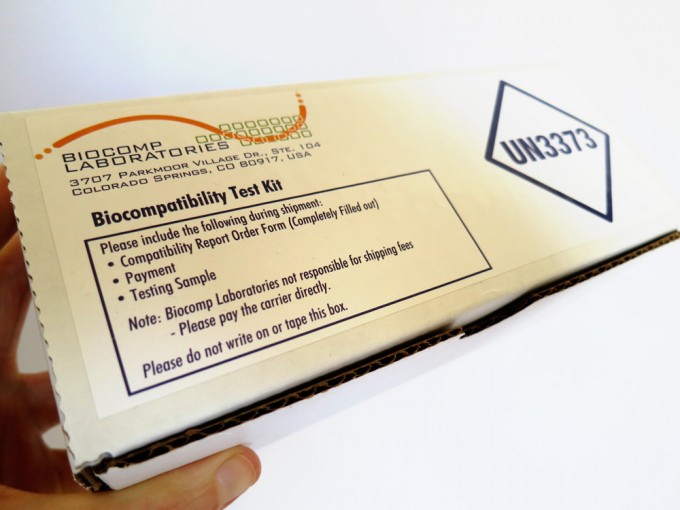
[This blog details heavy metal biocompatibility testing as regards dental materials placed in the body long term.]
In 2008, I had the last of my dental mercury fillings removed, which promptly put me back in intimate touch with my old standby, Big C. The connection between heavy metals and cancer is one I know very well, though it is also one that the mainstream medical system likes to say doesn’t exist, thus my recent excursion into finding and taking a blood serum test that told me whether or not I was mercury reactive based on scientific analysis.
The dental work itself was sloppy – leaving several mercury tattoos and a cracked tooth – and not following the recommended Huggins protocol for safe removal of heavy metals for me saw new melanomas cropping up over 2009, 10, 11 and 12, all capped off by the crowning event of late: a left breast cancer lesion.
As usual, I’m in it to win it. And along the way, gather as much proof along the way as I can, first for me and secondly for all those naysayers who think I’m off my nut for “believing” in heavy metals toxicity. It is not a question of belief, it is a question of testing to see if I’m reactive, how much toxicity is in my system, and then figuring out what to do about it.
While dealing with my left breast nipple lesion in 2012, I read some very interesting things about how teeth are connected to specific organs and systems in the body via meridians, as in Chinese medicine. No real surprise to me that the left breast corresponded tooth-wise with the upper left first molar, where, interestingly enough, a very noticeable mercury tattoo still lived on the tooth and gumline (see the dead set sexy pic of the interior of my mouth above where you’ll notice the grey-tinged areas above and on the tooth of concern). When I was a kid, this tooth developed a full-on hole on its inner surface on the gumline, which was filled by…drum roll, please…silver-mercury amalgam. As the American Dental Association declares on its website:
Dental amalgam is considered a safe, affordable and durable material that has been used to restore the teeth of more than 100 million Americans. It contains a mixture of metals such as silver, copper and tin, in addition to mercury, which binds these components into a hard, stable and safe substance. Dental amalgam has been studied and reviewed extensively, and has established a record of safety and effectiveness.
The FDI World Dental Federation and the World Health Organization concluded in a 1997 consensus statementi: “No controlled studies have been published demonstrating systemic adverse effects from amalgam restorations.” Another conclusion of the report stated that, aside from rare instances of local side effects of allergic reactions, “the small amount of mercury released from amalgam restorations, especially during placement and removal, has not been shown to cause any … adverse health effects.”
[Source: American Dental Association]
My response? My ASS.
And I’ll give you even more than that: a material safety data sheet on mercury (and here’s one on dental amalgam alloy). It took about 30 seconds on a wireless internet connection to find all these, so please read them for yourself and do your own research as well to see where your opinion falls on the ADA’s statement.
I’ve heard plenty of “it’s all in yer head, Sweetie” – enough for me to get into the habit of questioning everything that’s ever been said to me by a mainstream medical practitioner. In my experience, suggesting to a mercury-sensitive individual that mercury or other toxins aren’t possible culprits in chronic diseases (such as cancer) is like telling a peanut-allergic individual to get over it and have a Reese’s.
As well, the ADA hasn’t studied yours truly, and as someone who is sensitive to mercury (tested, yes) and who seems to have no problem retaining too much of it in my tissues (tested again – and a genetic predisposition, from what I’ve read regarding certain genotypes not being able to excrete metals efficiently), I have to ask: Who the hell paid the ADA to state such things?
Given my experience with insurance companies that refused to cover mercury removal (otherwise they’d get found out and have to do a whole lotta freebie dental revisions, I suppose), my trust in the ADA regarding the mercury toxicity issue doesn’t even register. Their interests and my interests are divergent – ne’er shall their paths cross – and science corrupted by money isn’t really science, and all that.
I first discovered there was a blood serum biocompatibility test for heavy metals in the form of dental materials when I started talking with the American Bio Dental Clinic in Tijuana, Mexico. They encouraged all their patients dealing with cancer to have one, and for me, it was a no-brainer as I’m always after proof of what is actually going on…not what someone “thinks” just by looking at me, aka the Bill Frist “diagnosis.” Only when I see the real deal picture can the action I take be accurate and effective.
The test recommended to me was the Biocompatibility Test Kit from BioComp Labortories in Colorado Springs, Colorado in the US of A, which American Bio Dental forwarded directly to me previous to my initial scheduled dental revision in Tijuana. The picture behind this blog post (toggle the content away and back by clicking the round button with the + or – sign in it) shows what the test kit’s box looks like, including the test number (UN3373) along with the lab’s address and simple instructions.
Contents of the test kit include paper work (a Compatibility Report Order Form, Lab Instructions, Patient Instructions, FAQs and a Request for Client Serum Sample). In addition, there is a styrofoam container with a serum tube, outer tube and two small freezer packs that must be frozen for serum shipment to the lab for testing.
After fasting overnight per the instructions, I took the kit first to LabCorps, which had this test in their system under the instructions “Do NOT Use – Pending” and could not do the blood draw. Then it was on to Quest Diagnostics, who happily did the test per the instructions. After the blood draw and my payment, Quest sent my kit directly to BioComp Labs for the analysis.
The total cost for this was as follows:
$350 Serum Biocompatibility Test (including shipping & compatibility report)
$41.80 Blood draw at Quest Diagnostics:
$391.80 – Grand Total (and note that this test was not covered by insurance – nor was I – at the time it was done in mid-November, 2013)
When I got the results back from BioComp’s Blood Serum Compatibility Test, I was not at all surprised. This is further validation for what several top-notch holistic medical pros claimed was a major factor in the health problems I’ve had.
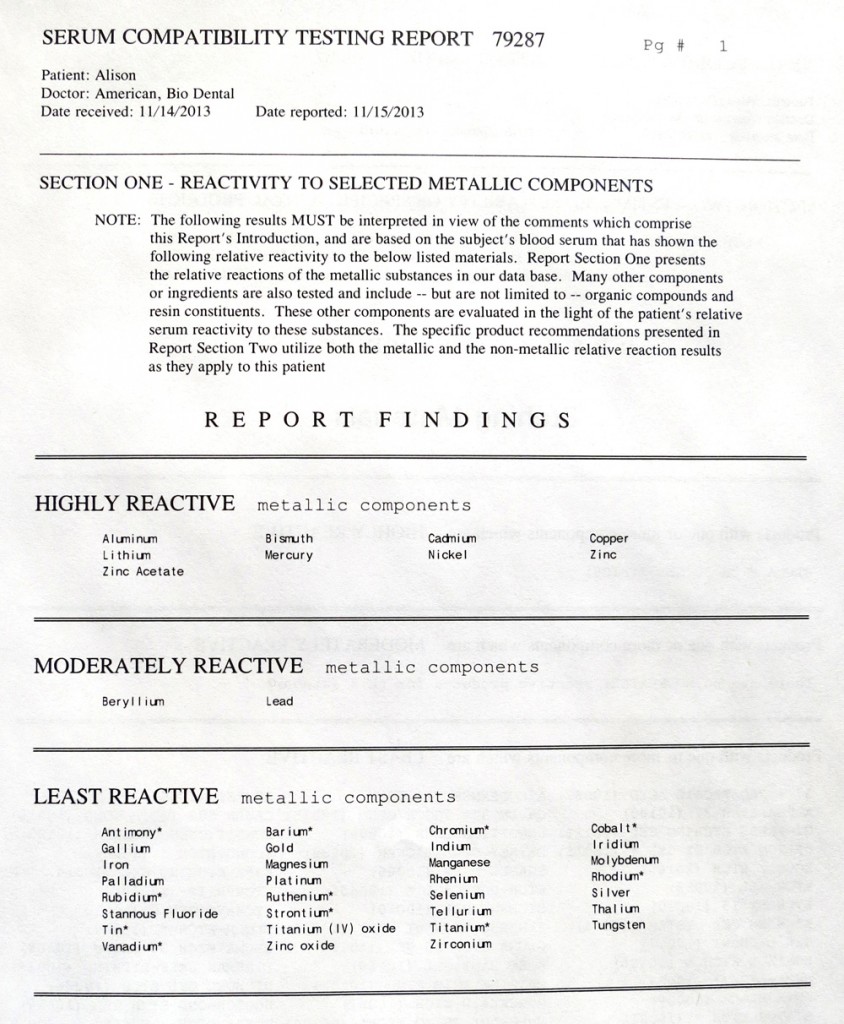
Page 1 from BioComp Labs’ report (see above image) contained a listing of dozens of metals used in various dental materials, separated by reactivity level in me as the subject tested via blood serum analysis.
As you can see for yourself above, in the Highly Reactive category was my old pal mercury and a few other heavy metallic malcontents, including nickel (petro fumes, cigarette smoke, cookware, etc.), aluminum (cans, foil, cookware, etc.), lithium, cadmium, copper…and even zinc and zinc acetate.
Of interest was bismuth, that ingredient in Pepto-Bismol (or Pink Bismuth if you’re going generic) that also showed up in the Highly Reactive category. I’m not sure what the full interpretation of this is, because Pepto-Bismol seems to work just fine for me (though I rarely use it, so that may be telling).
Silver and gold turned up in the Least Reactive category (of course, I’ve always had an affinity for those :-)). So did Titanium and Zinc oxides (used in sunscreens and other products), Stannous Flouride (toothpastes) and plenty of other metals.
This testing report also contains dozens more pages of thousands of dental materials, categorized as Highly, Moderately or Least Reactive. The American Bio Dental Clinic in Tijuana informed me they use a product called Diamond Crown for composites, fillings and inlays (most of the work I’ve had done by them), and this showed up in my report as being among the Least Reactive. That is good news! Anything that is permanently fixed in my mouth had better fall into that category, otherwise it’s yet another possible cause for the cancer cup to runeth over.
This brings me to some commentary on the dental industry as a whole, speaking from the experience of years spent down the hole on mercury toxicity and other issues that could have easily been prevented had my childhood dentist simply tested me for compatibility with dental mercury amalgam. The fact that at least a dozen amalgams were placed in my mouth without my knowing the possible effects – or even being given a choice in the matter – illustrates everything that is wrong with the mainstream medical system and its largely one size fits all mentality.
Considering that Romney-Obamacare doesn’t yet include this type of biocompatibility test as part of a larger preventative scheme, it needs revision – and soon. Having read that we are now exposed to more toxins in 15 minutes than our grandparents were over their whole lives makes lowering the body’s burden even more critical than ever.
Yours in good health,
Alison
PS – BioComp Laboratories can be found via www.biocomplaboratories.com and the American Bio Dental Clinic by pointing to www.americanbiodental.com. Ain’t research fun? Cheers…
[Contents of this post are for educational purposes only and all that jazz.]
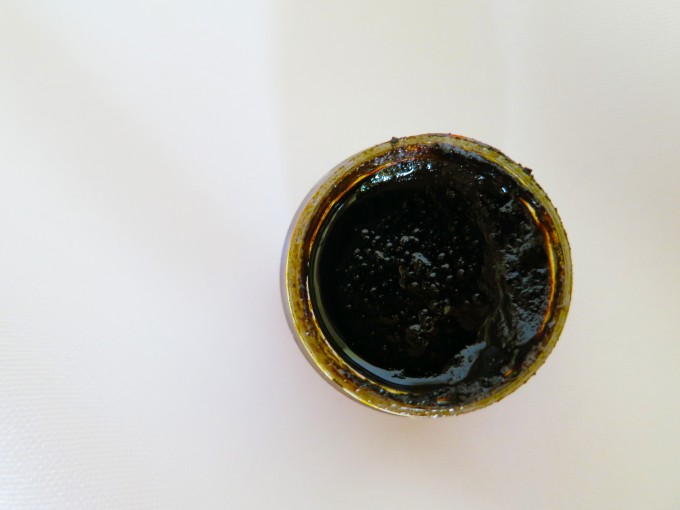
[This is the First Part of my Series on black salve. All I can say is, there will be others.]
Black salve has been one of my cancer treatments of choice for the past 12 years since my melanoma diagnosis in Doylestown, Pennsylvania in 2001.
I found it first at herbhealers.com, thanks to some generous souls online whose healthcare nightmares mirrored my own. Days after my diagnosis, I visited their website and saw this: 100% Money Back Guarantee.
I was certainly in brand new territory, so I bought a small container of the stuff, which, upon arrival, looked and smelled like electronic licorice and was about the same color. It was thick, pungent and deep – and I got the feeling that when I was looking at it, it was looking straight back at me (cue theme from The Twilight Zone).
Following the instructions opened up my eyes to a brand new world: one where cancer treatments were both highly effective and inexpensive (in the case of my little tub of black salve, just under $25). This was my first step to freedom from the ineffectual circle jerk of pills, surgeries and doctors who never bothered getting to the root of the issue and solving it, but collected nonetheless.
After trying black salve out on a couple melanomas, I was sold. I said “shove it” to the gettajob-to-pay-for-pharma-based-healthcare half-life. I’d been on that downward spiral long enough, and there was nothing like a Big C diagnosis as a lead-in to going entrepreneurial and constructing my own path to healing. It really opened my eyes to the way much of society is actually run – and I discovered along the way that The Giant Sucking Sound wasn’t coming from me.
The first melanoma on which I used the salve was one I’d nicknamed Half’n’Half: a half-pink, half-brown, all-weird creature living on my skin with a black spot right in the middle where the two halves met in a perfectly straight line. It looked like something I’d encounter in Stephen King’s short, The Mist – or perhaps in a museum of modern art.
That just wasn’t right. Biopsies told me as much.
I put a fingertipful of the salve on Half’n’Half, and almost immediately, the sensation described in the lit that came with the Salve became reality: that of a rubber band snapping against my skin.
This continued for almost a day as the salve had its way with the mole, which later became like a solar eclipse, featuring a large black spot with a white halo around it, surrounded by another slightly pink halo of inflammation as this cancerous mole-monster was successfully treated. Eventually, the lesion became a dried-out scab as the skin below pushed the whole mess out of my body. Good riddance!
A couple weeks in, it fell off, leaving a slight indentation that filled back in over time and left a slightly scarred area that was a hair lighter than my normal skin tone. Looking at the fallen scab, I saw two black helical tendrils floating down from the pitch-dark mass in its middle. This got me thinking that I was staring at something that very possibly could have killed me if I hadn’t intervened.
In the years following, I’ve treated dozens of skin lesions, including several on my face as well as a breast nipple lesion that first appeared in late 2011 and became a real problem in 2012 (do check that one out – it’s a real doozy!). All using the same small container of black salve I’d bought in 2001, the same one I’d shared with friends, skeptics and willing-to-try-it-types. All were amazed at the results and often came back to me with questions on where to get it.
What works…works.
This was also the same container I’ve brought with me to various doctor’s offices, attempting to inform my white-coated compatriots about how well the salve worked. On many such occasions, I got the denial routine, after which I got up and left, telling the front office staff not to bother sending me a bill. I guess if your livelihood depends on a system that must outlaw or deny its far less expensive, but highly effective competition within what is heavily marketed to us as a “free market” system, that speaks for itself. Suffice it to say: science corrupted by money is not science at all.
Over time, black salve has proven itself a very effective tumor debulking agent that costs a tiny fraction of all the surgeries I’d have needed, if I’d chosen the surgical route.
A few black salve resources:
- The Black Salve Page on Facebook
- Search on the term “Black Salve” on YouTube
Yours in Good Health,
Alison
On to Part 2 in this Series: My Big Black Salve Boob Job
[Contents of this post are for educational purposes only and all that jazz.]
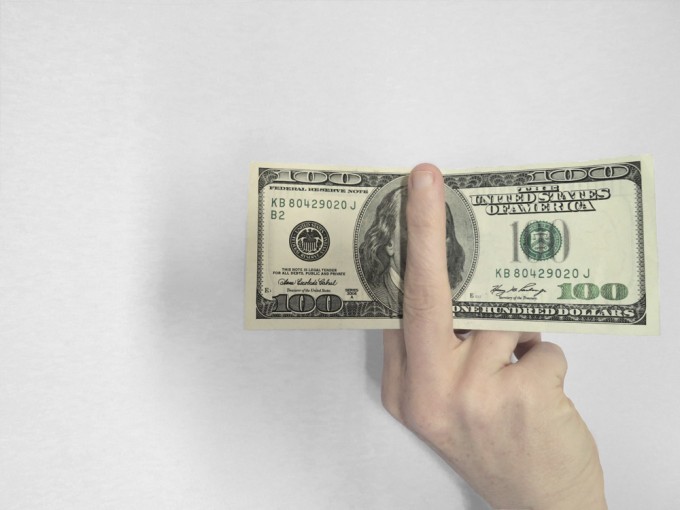
It was very fitting how I learned of Breaking Bad. A friend and fellow cancer fighter, whose own battle started with melanoma – and later, stage 4 prostate cancer and then some – told me about this cool new show he’d been watching. It featured a very smart, but very broke school teacher working two jobs…and he had lung cancer on top of it all. In other words, someone who’d had enough.
Ding.
He’d had it to the point where he’d started making and selling meth to pay medical bills and provide for his family…and to make up for the deficits he saw in his own existence.
Ding.
The main character of the show, one Walter Hartwell White, played to perfection by Bryan Cranston, had also felt the sting of the Big Fuck You Over Money via two former business partners, who’d become billionaires on the back of Walter’s chemistry genius after he left the company. He went near-broke, barely eking out a living as a schoolteacher moonlighting at the local car wash. And now, he wanted his cut of the Big Pie. However he could get it.
Ding! Ding, ding, ding-ding-ding-ding-diiiing!
As the description came out of my friend’s mouth, I was immediately hooked. One cancer survivor who’d been screwed over telling another about a show featuring yet another. There was a love triangle in there somewhere.
As I started to watch back episodes to catch myself up, I saw in Walter White shades of yours truly.
Firstly, cancer. The day of my diagnosis was a game changer. I was never the same. Never looked at things the same way again. Did some things I’m not proud of.
Most of the past years since my diagnosis, I’ve not had access to “the system.” Sometimes I had health insurance, sometimes not. Seeing as I prefer holistic healthcare and treatments other than those offered by Big Pharma-racketed US Sick’n’Pay, I think that was in many ways for the best. For me, it was a good thing not to have access to too many pharma drugs. All they ever did was crash my immune system, making me sicker with each pass. But not so good when I needed a decent and timely diagnostic. Or necessary surgery and dental care.
Secondly, career frustration. Majorly. Won VH1’s Song of the Year, twice. Sold over 100,000 units of my tunes, largely soundtrack and overseas indies. Still no big, life-changing deal, and way too many questions…but I sure found out what “several layers of record label accounting” really means.
Thirdly, financial devastation. Even working through the Big C for the Big Dream. Flashback to 2004. Three jobs. Made Bush proud! Lesson: ‘work hard and you’ll make it in America’ is a great soundbite, but don’t ask me to believe it after all I’ve seen and experienced. Proof in the form of a million-dollar music publishing deal would be far more convincing and practical.
LOL! Don’t laugh – that was my original goal in entering The Biz. That, and access to decent medical. Such was life in these United States.
But now, like Walter White’s ever-increasing monetary goals, mine, too, have grown. Because as anyone who’s experienced the Big Fuck You Over Money can tell you, it puts a fire under your ass. Because life should be more than chasing illnesses, mere survival and the constant mind-chatter of rotating what ifs.
The reason for Breaking Bad’s success is that it touched those same raw nerves in so many millions of others. We all want to Break Big. And some are willing to Break Bad to do it. I can certainly relate.
Which brings me to this point: Breaking Bad was damn close to perfect. So damn close to perfect. Vince Gilligan of X-Files fame made it perfect in every way, except for one little, BIG thing.
I think back to the episode where Walt’s doctor is discussing alternative treatments for cancer – and the off-the-main-drag-but-still-Pharma-biased doctor’s canned response came in like a rainstorm on a parade when he mentioned his uncertainty about the efficacy of such treatments.
So, yes, Hollywood manages to mention alternative treatments. But then there’s the suited Dr. Deus ex Machina, telling us all about a lack of efficacy associated with them.
Hmmmmm.
Anyone else smell the Big Pharma bucks behind that?
Because honestly, that hasn’t been my experience. In fact, just the opposite. Pharma drugs were what created my Big Mess in the first place. Treatments outside of those pushed on us by Big Pharma have largely gotten me back to some semblance of health. But I certainly am still chasing things down, given that FDA-approved drugs almost deep-sixed my skinny ass.
Thus my request to Hollywood: Why not come up with a show that follows a cancer-fighting character, preferably someone who, in “real life,” has or had the disease – WE need the money. And please, make the protagonist someone using alternative, holistic medicine – if alternative even applies to treatments existing thousands of years B.C., aka Before Chemo. Make it a story about someone for whom the system has failed, who realizes the only way out is to Break Brave and follow his or her gut instincts. Kinda like I – and a lot of others – had to.
When – IF – Hollywood Breaks Brave (and decides to go truly free market where cancer treatments are concerned), I’ll be all-in. A 100% FAN! Behind-the-scenes experience tells me that many celebs use alternative, holistic healthcare, but still do and say whatever their corporate paymasters order them to do and say for a paycheck.
Tragic. And certainly not role model material.
When both Hollywood and doctors serve as guides, not gods – and no longer serve Big Pharma to the exclusion of all else over money – that will be the day. And if the day comes when I see universal, single-payer, sliding-scale healthcare featuring a full set of choices for cancer treatments in America, I’ll be first in line.
Yours in Great Health,
Alison

